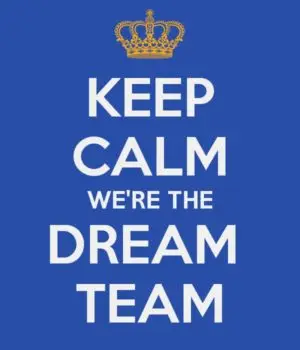This blog is part of the Analyzing Scoliosis series, which is designed to teach movement practitioners how to work confidently with clients who have scoliosis. In previous posts I discussed the typical scoli body, common types of scoli (AIS and functional scoliosis), when to work with a client, handling misdiagnosed client, the importance of movement, and the role of the instructor. My book, Analyzing Scoliosis, which covers the topics in this series (as well as others) in more depth, is available on Amazon.
What is a dream team? Why do you need one? I think the heart of the answer lies in how the medical community treats scoliosis patients. Even though research has proven that movement helps scoli, most western medicine students and practitioners give very little consideration to physical exercise as a form of therapy for scoliosis (1).
Because of this, the medical world typically treats scoliosis with a “one-and-done” approach. Rather than send a patient on their way with instructions to exercise regularly, most medical practitioners choose to treat with a brace or surgery to “fix” the scoli. Why?
If healthcare professionals give a patient instructions to exercise, one of two things happen: the patient will follow through and their scoli will be successfully managed through movement or the patient will not follow through and their scoli will not be successfully managed, leaving the patient with chronic pain and never-ending health issues stemming from their scoli. Statistically speaking, the follow-through rate is of patients following doctors’ instructions is horribly low (2).
Exercise is obviously not a “one-and-done” approach. People with scoliosis need to move for the rest of their lives. This is where you, as a Pilates instructor with scoli clients, have to step in and prove that it is possible to change that low follow-through statistic.
As someone with scoli, I personally refuse to contribute to that crummy follow-through statistic. As a movement practitioner, you have the unique opportunity to be a beacon of inspirational light for your scoliosis clients, and prove to them that they can and should keep moving every week while they are still breathing the breath of life on earth.
Sound like a heavy load to carry? It is, in some ways. But, you and your scoli clients are not the only ones carrying the weight. In fact, I recommend that scoliosis clients find a “dream team” of other practitioners (in addition to you, their trusted Pilates instructor!) who can help them live pain-free lives. Encourage your scoli clients to seek help from other professionals in your town or community, including but not limited to:
- A massage therapist. Encourage your clients to find a good therapist who has knowledge about scoliosis and has studied a myriad of techniques like Myofascial Release, Rolfing, Structural Integration, trigger point therapy, neuromuscular therapy, or craniosacral therapy—these are particularly beneficial to those with scoli. Almost every single scoli client of mine sees a great manual therapist who can put hands on their spine and release the bound tissue, allowing the spine to unwind more. This will help you tremendously because your client’s spine won’t be as tightly wound, allowing you to lengthen and move your client’s spine in a straighter position.
- A physical therapist. If you have a therapist you trust, refer your client to them. Keep an open relationship with the therapist so you can collaborate and share pertinent notes. The Schroth Method is a branch of physical therapy that is specifically designed for scoliosis, but note that it can be difficult to find someone who specializes in this.
- A GYROTONICⓇ practitioner. This form of exercise is characterized by circular, spiraling movements that help with three-dimensional body awareness, and can increase functional capacity of the spine.
These all serve as additional team players for your scoli clients. Of course, each body will have different needs, but these are great starting points in your client’s journey to owning their scoli and their health outside your studio walls.
Stay tuned, in the next several posts I will dive deep into the particulars of how to analyze a spiral spine.
Sources
1 Negrini, S., Antomini, G., Carabalona, R., & Minozzi, S. “Physical exercises as a treatment for adolescent idiopathic scoliosis. A systematic review.” Pediatric Rehabilitation, vol. 6, no. 3-4, 2003, pp. 227-235.
2 Evangelista, Lorraine S., & Shinnick, Mary Ann. “What Do We Know About Adherence and Self-Care?” The Journal of Cardiovascular Nursing, vol. 23, no. 3, 2008, pp. 250–257.
